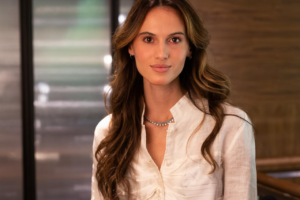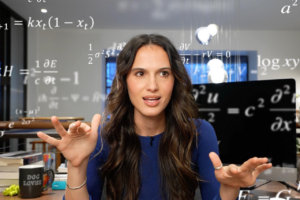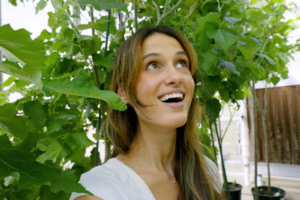In the dimly lit editing rooms of traditional newsrooms, visuals were often an afterthought—supplementary elements added to break up walls of text. But as Cleo Abram demonstrates through her work on “Huge If True,” this approach has been turned on its head in the digital age. Her “visual-first” philosophy represents a fundamental shift in how stories are conceived, developed, and told.
At the heart of Abram’s methodology lies what she calls the “napkin test”—a deceptively simple yet powerful litmus test for determining whether a story deserves visual treatment. “If you’re thinking about a story and you need to draw something on a napkin to explain it to someone, that’s a good video story,” she explains. This intuitive approach echoes the natural way humans process and share information, reminiscent of those eureka moments when complex ideas crystallize through simple sketches.
Consider, for example, her episode about ocean mapping. The key visual—a comparison between the resolution of Mars maps versus ocean floor maps—wasn’t merely decorative. It served as the narrative backbone, a recurring touchstone that helped viewers grasp the astounding gap in our understanding of these two frontiers. This approach transforms what could have been a dry statistical comparison into a compelling visual story that stays with viewers long after the video ends.
But Abram’s visual philosophy extends beyond mere illustration. She emphasizes that visuals must do “explanatory work.” In her words, “The visual can’t just be like if you see a video of a plane crash from afar—it doesn’t necessarily tell you anything about why that happened.” Instead, she searches for visuals that reveal mechanisms, demonstrate relationships, or illuminate processes. This distinction between decorative and explanatory visuals marks the difference between content that merely shows and content that truly teaches.

The implementation of this philosophy requires a complete inversion of traditional content creation processes. Rather than writing a script and then finding visuals to match, Abram’s team builds their narratives around key visual moments. This approach manifests in their unique three-column script format, where the middle column—dedicated to visuals—often drives the content in the left column (the spoken narrative) rather than the other way around.
What makes this approach particularly powerful is its alignment with how modern audiences consume and process information. In an era where attention is increasingly visual and increasingly fragmented, leading with strong, explanatory visuals isn’t just good storytelling—it’s essential for engagement. The success of “Huge If True” demonstrates that viewers aren’t just willing to engage with complex topics; they’re eager to do so when the visual storytelling guides them through the complexity with clarity and purpose.
This visual-first approach represents more than just a production methodology—it’s a fundamental reimagining of how stories can be told in the digital age. By placing visuals at the center of the storytelling process, Abram has created a framework that not only serves the needs of modern audiences but also enhances their understanding of complex technological concepts.
In an era where content creation often feels like a race to produce more, faster, Cleo Abram’s methodical four-step framework stands as a testament to the enduring value of thoughtful preparation. Her approach, refined through years at Vox and perfected with “Huge If True,” transforms the often chaotic process of video creation into an elegant symphony of planning and execution.
The journey begins with what Abram calls the pitch document—a crucial foundation that requires creators to articulate not just what they want to say, but how they plan to show it. “The pitch should take about half an hour to create,” Abram notes, “but it should be the result of prolonged interest.” This initial step forces creators to distill weeks or months of casual research and curiosity into a focused narrative proposition. Like an architect’s blueprint, the pitch document doesn’t just outline the story; it validates its visual viability before any production begins.
Following the pitch comes the information documentation stage, or what Abram calls the “info doc.” If the pitch is the blueprint, the info doc is the gathering of materials—a methodical collection of every visual element that might serve the story. “Think about it like building a brick wall,” Abram explains. “The info doc is like collecting all of the bricks and putting them in organized piles.” This stage often involves 40 or more rows of potential visuals for each section, creating a rich palette from which the final story will be painted.
The third step, the visual outline, transforms this collection of raw materials into a coherent narrative sequence. Here, rough sketches and placeholder images begin to tell the story, even before a single word is written. It’s a process that might seem backward to traditional content creators, but it ensures that the final product remains true to its visual-first philosophy. Even crude drawings in Google Slides serve as crucial waypoints in the storytelling journey.

Finally, the script emerges as a three-column document—a format that places visuals literally at the center, flanked by narrative content on one side and sources on the other. This structure isn’t merely organizational; it’s philosophical, ensuring that every word serves the visual story rather than the other way around.
What makes Abram’s framework particularly compelling is its scalability. While she typically allows two to three months for videos requiring field shoots, the same principles apply to shorter content. The framework acts as a quality control system, catching weak concepts early in the process. “If you can’t fill something in,” Abram notes, “then you shouldn’t be pitching it in the first place.”
This systematic approach might seem intensive for today’s fast-paced content landscape, but its results speak volumes. Each step builds upon the last, creating a foundation so solid that the final creation process becomes almost inevitable. It’s a reminder that in content creation, as in architecture, the time spent on planning often determines the strength and longevity of the final structure.
For creators looking to elevate their content beyond the algorithmic churn, Abram’s framework offers a path to creating work that not only captures attention but rewards it with substance and clarity. It’s a process that honors both the creator’s vision and the audience’s intelligence, proving that even in the digital age, methodical craftsmanship still has its place.
In the ever-evolving landscape of digital content, where the line between creator and journalist often blurs, Cleo Abram’s approach offers a masterclass in maintaining journalistic integrity while embracing the creative freedom of independent production. Her work demonstrates that the fundamentals of good journalism aren’t just compatible with creator-driven content—they’re essential to its elevation.
At the heart of Abram’s methodology lies a profound respect for sourcing. Unlike the common practice of recycling information from secondary sources, she emphasizes the importance of reaching out to primary sources—even when they seem out of reach. Her successful pitch to NASA serves as a testament to this approach. “The perfect email can be read in one with no swipes on your phone,” she explains, highlighting how even the most prestigious institutions are accessible when approached with clarity and purpose.
The integration of expert voices in Abram’s content goes beyond mere credibility-building. She positions herself not as the ultimate authority but as a proxy for her audience’s curiosity. “I’m not the main character of my show,” she emphasizes. “I introduce them to a new main character in every episode.” This humble approach to expertise reflects a core journalistic principle: the story is always bigger than the storyteller.
Perhaps most striking is Abram’s commitment to transparency about the depth of her knowledge. In her first video about fracking technology, she openly acknowledged spending a month researching the topic and invited experts to continue the conversation. This level of honesty about the boundaries of one’s expertise—rare in the creator economy—builds trust while maintaining journalistic integrity.
Her treatment of complex topics demonstrates another crucial journalistic principle: making the complex accessible without oversimplification. “Never underestimate your audience’s intelligence, and never overestimate their prior knowledge,” she advises. This delicate balance is achieved through what she calls “very simple language but very complex ideas,” an approach that honors both the subject matter and the audience’s capacity to understand it.
The result is content that serves a higher purpose than mere entertainment or information delivery. Each piece becomes a bridge between expert knowledge and public understanding, crafted with the rigor of traditional journalism but delivered through the engaging formats of modern content creation. This synthesis creates something new: journalism that doesn’t just inform but invites viewers into the process of discovery.

For creators aspiring to add journalistic depth to their content, Abram’s approach offers several key lessons: prioritize primary sources, acknowledge the limits of your expertise, maintain transparency about your research process, and never sacrifice accuracy for entertainment. These principles, when applied thoughtfully, can transform content from merely engaging to genuinely enlightening.
The future of digital journalism may well lie in this hybrid approach—where the accessibility and creativity of content creation meets the rigor and responsibility of traditional journalism. As Abram demonstrates, it’s possible to maintain high journalistic standards while building a successful creator-driven platform. The key lies not in choosing between being a creator or a journalist, but in understanding how these roles can enhance each other.
The journey from institutional media to independent creation often feels like stepping off a well-lit stage into an uncertain spotlight. For Cleo Abram, this transition from Vox to launching “Huge If True” exemplifies how thoughtful preparation and clear vision can transform that uncertainty into opportunity.
When Abram left Vox, she didn’t just leap into the creator economy—she orchestrated a careful landing. With approximately 400,000 TikTok followers already engaged with her content, she had built what many would consider a comfortable safety net. Yet her approach to monetization revealed a deeper understanding of professional integrity. “I always turned down sponsorships,” she recalls of her time at Vox, demonstrating how building credibility sometimes means saying no to immediate opportunities for longer-term gains.
The launch of “Huge If True” wasn’t merely about creating content—it was about creating an identity. Working with designer Whitney Theus, Abram crafted a visual language that challenged the dominant aesthetic of technology journalism. Where others defaulted to “black and gray with one neon color,” reminiscent of dystopian futures, she chose earth tones and organic elements. This deliberate departure from the “Tron-like” aesthetic of tech media wasn’t just about standing out—it was about standing for something: a more optimistic, grounded vision of technology’s future.
Her approach to launch timing proved equally strategic. Rather than rushing to market, Abram took a month to prepare, ensuring she had one complete episode produced before even releasing her trailer. “I wanted to have done it once before I released the trailer,” she explains, “to know that I was right to describe it that way.” This methodology—testing the reality against the vision—demonstrates a level of professional rigor often missing in creator transitions.
The business model emerged organically from her existing platform. Initial sponsorships on TikTok helped fund the early episodes of “Huge If True,” creating a bridge between platforms that many creators struggle to build. This cross-platform strategy allowed her to maintain independence while building a sustainable foundation for growth.
Perhaps most notably, Abram approached her independence not as a rejection of traditional media but as an evolution of its principles. Her commitment to journalistic rigor, combined with her vision for “Black Mirror but the opposite,” created a unique value proposition in the creator economy. She wasn’t just leaving an institution—she was building one of her own.
For professionals contemplating similar transitions, Abram’s journey offers several key insights: build your audience before you need it, test your concept before you announce it, and ensure your visual identity aligns with your broader mission. Most importantly, treat independence not as freedom from structure, but as an opportunity to build better structures.
The success of “Huge If True” demonstrates that the gap between institutional media and independent creation isn’t as wide as it might appear. With careful planning, clear vision, and unwavering commitment to quality, it’s possible to build a bridge across that gap—one that others might follow.
In the rapid-fire world of social media, where attention spans are measured in seconds and algorithms favor brevity, Cleo Abram’s approach to short-form content stands as a masterclass in distillation without dilution. Her 60-second videos, often filmed casually with a coffee cup in hand, might appear deceptively simple, but they represent a carefully crafted balance between accessibility and substance.
“This is blank, yes it matters because blank,” Abram explains, breaking down her short-form formula to its essence. This seemingly simple structure belies a sophisticated understanding of how information travels in the digital age. Take her recent work on the Nobel Prize in physics—rather than attempting to compress the entirety of quantum mechanics into a minute, she focuses on a single, powerful visual comparison that illuminates the scale of atomic science.
The casual aesthetic of these videos—filmed on a phone, often in what appears to be impromptu moments—is itself a strategic choice. “I want my short-form to feel like I’m just FaceTiming you and explaining something,” Abram notes. This approach creates an intimate connection with viewers, making complex topics feel more approachable. Yet behind this apparent spontaneity lies a rigorous process: each video still begins with a pitch and visual concept, though scaled appropriately for the format.
What sets Abram’s short-form strategy apart is her understanding that brevity doesn’t necessitate superficiality. Her videos maintain the same commitment to visual explanation that defines her longer content, just concentrated into a more potent form. “You need to understand how small that is,” she explains about displaying atomic scale, demonstrating how even in 60 seconds, there’s room for meaningful context and comparison.
The real art lies in what Abram chooses to exclude. Where many creators might try to pack multiple points into a short video, she maintains a laser focus on a single idea, supported by one key visual. This discipline ensures that viewers walk away with a clear understanding rather than a blur of half-grasped concepts. It’s the difference between taking a sip of espresso and trying to drink an entire pot of coffee in one gulp.
Perhaps most importantly, Abram views her short-form content not as a compromise but as a complementary format to her longer work. These bite-sized explanations serve as entry points, inviting viewers into deeper explorations of complex topics. “If it deserves decades of academic research,” she notes, “it definitely deserves a longer video.” But sometimes, a well-crafted minute can plant the seed of curiosity that blooms into sustained interest.
For creators navigating the demands of multiple formats, Abram’s approach offers valuable lessons: maintain your standards across all formats, understand the unique strengths of each platform, and never confuse brevity with lack of depth. In a world increasingly dominated by short-form content, these principles help ensure that even the briefest interactions can carry meaningful impact.
The success of this strategy demonstrates that in content creation, as in science, elegance often lies in simplification without oversimplification—finding the essential heart of an idea and presenting it with clarity, regardless of the time constraint.
In an era where content creation often feels like a race to the bottom, with creators sacrificing quality for quantity and depth for virality, Cleo Abram’s methodical approach to digital storytelling offers a refreshing counternarrative. Her success with “Huge If True” demonstrates that thoughtful, well-researched content can find its audience without compromising journalistic integrity or creative vision.
The synthesis of her methods—from the four-step content framework to her visual-first philosophy, from journalistic rigor to short-form adaptation—creates a comprehensive blueprint for modern digital storytelling. But perhaps more importantly, it challenges the prevailing wisdom about what audiences want. As she puts it, “Never underestimate your audience’s intelligence, and never overestimate their prior knowledge.”
What makes Abram’s approach particularly valuable is its scalability. Whether crafting a detailed exploration of quantum computing or a 60-second explanation of the Nobel Prize in physics, the fundamental principles remain consistent: start with the visual, prioritize explanation over illustration, and maintain unwavering respect for both the subject matter and the audience.
Her transition from traditional media to independent creation also offers important lessons about building sustainable creative businesses. By focusing on quality over quantity, developing a distinct visual identity, and maintaining professional standards across all formats, she’s demonstrated how creators can build authority and audience trust simultaneously.
As the lines between traditional journalism and digital content continue to blur, Abram’s work suggests a future where these distinctions may become less relevant. What matters isn’t the platform or format, but the commitment to storytelling that enlightens while it engages. Her success indicates that audiences are hungry for content that treats them as capable of understanding complex ideas, provided those ideas are presented with clarity and purpose.
For creators, journalists, and storytellers of all stripes, the lesson is clear: in a world of infinite content, quality still cuts through. The future of digital storytelling may well belong to those who, like Abram, dare to slow down, think deeply, and trust their audience’s capacity for understanding. As she continues to grow her platform, her methodology serves as both inspiration and instruction for the next generation of digital storytellers.
The legacy of “Huge If True” may ultimately be less about the specific stories it tells and more about how it tells them—proving that even in the fast-paced world of digital content, there’s still room for thoughtful, methodical approaches to storytelling that prioritize understanding over entertainment, and substance over speed.
In a digital landscape often dominated by quantity over quality, Cleo Abram’s methodical approach to content creation stands as a testament to the enduring value of craftsmanship. Her work on “Huge If True” isn’t just about explaining complex technological concepts—it’s about pioneering a new form of digital storytelling that marries journalistic rigor with creative innovation.
The brilliance of Abram’s methodology lies in its versatility. From long-form investigations into quantum computing to 60-second explanations of Nobel Prize-winning research, her framework adapts while maintaining its core principles. This flexibility demonstrates that quality content isn’t about length or format—it’s about the thoughtful application of fundamental storytelling principles.
Perhaps most striking is how Abram’s approach challenges conventional wisdom about audience engagement. In an era where content creators often chase algorithms with clickbait and surface-level coverage, she proves that audiences hunger for substance. Her growing success suggests that viewers don’t just want to be entertained—they want to understand. As she puts it, “Never underestimate your audience’s intelligence, and never overestimate their prior knowledge.”
This philosophy extends beyond individual videos to shape entire content strategies. By emphasizing visual storytelling, maintaining journalistic integrity, and respecting audience intelligence, Abram has created a sustainable model for educational content that doesn’t sacrifice engagement for accuracy. Her four-step content framework, from detailed pitch to polished production, offers a blueprint for creators looking to elevate their work beyond the algorithmic churn.
Looking ahead, Abram’s work suggests a future where the boundaries between traditional journalism and digital content continue to blur. As she demonstrates, the key to success in this evolving landscape isn’t about choosing between depth and accessibility—it’s about finding innovative ways to deliver both. Her integration of journalistic principles with creator-driven formats points toward a new paradigm where authority and authenticity coexist.
For creators navigating this shifting terrain, Abram’s journey offers valuable lessons: invest in process, prioritize visual storytelling, maintain high standards across all formats, and above all, trust in audience intelligence. These principles, when thoughtfully applied, can transform content creation from a numbers game into a craft that serves both creator and audience.
As the digital content landscape continues to evolve, Abram’s methodology reminds us that some principles remain timeless. Whether explaining quantum physics or ocean mapping, the fundamentals of good storytelling—clarity, authenticity, and respect for the audience—never go out of style. In this way, “Huge If True” isn’t just a show about technology’s future—it’s a glimpse into the future of digital storytelling itself.
For those seeking to make their mark in digital media, Abram’s success offers both inspiration and instruction. It demonstrates that in a world of infinite content, quality still commands attention, and thoughtful process still produces results. As we look to the future of digital storytelling, her work suggests that the path forward isn’t about choosing between depth and accessibility—it’s about finding innovative ways to deliver both.


